Research on Mobile Marketing Recommendation Method Incorporating Layout Aesthetic Preference for Sustainable m-Commerce
Abstract
1. Introduction
2. Literature Review
2.1. Mobile Marketing Recommendation Methods
2.2. Layout Design and Quantification
2.3. Aesthetic Preference and Its Affecting Factors
3. Modeling
- Phase I, Recommendation list generation based on traditional user interests. Use existing content-based and collaborative-filtering methods, to generate a recommendation list. The process requires information about traditional user preferences. Traditional user preferences do not contain the information of user aesthetic preferences for interface layouts. Therefore, in this phase, the same data used by existing recommendation methods are used to generate a recommendation list.
- Phase II, Recommendation list generation based on aesthetic preference for layout. User aesthetic preferences for layout are used to generate a list of marketing recommendations. By using the layout aesthetic quantification method and aesthetic preference similarity method, we calculate similarities between layout designs and the layout aesthetic preferences between users, respectively. Modified content-based and collaborative-filtering methods are combined to generate a recommendation list based on layout aesthetic preference.
- Phase III, Recommendation list rearranging. The recommendation lists generated in the previous two stages are merged and sorted. The sorted recommendation list is output as the recommendation result. The recommended model framework of the method is shown in Figure 1.
3.1. Recommendation List Generation Based on Traditional User Interests
- Initialize the recommendation list with contents to satisfy traditional user interests and set it to ∅.
- If a preference records exist for , a content-based method is adopted. Let hold the preference records of , as , is the attribute vector of , for a marketing content , is the attribute vector of . If , then put into , is the similarity of and , is the threshold marketing content similarity.
- If there are no existing preference records for , a collaborative-filtering method is adopted. Pick a user from U, whose preference records exist in the system. For users and , and are the profile attribute vectors of and , respectively, represents the similarity of and . If , then put the items in ’s preferred list to , is the user similarity threshold.
- Returns
3.2. Recommendation List Generation Based on Aesthetic Preference For Layout
3.2.1. The Quantitative Method for Layout Design of Mobile Marketing Content Interface
3.2.2. User Similarity Measurement Based on Influencing Factors of Layout Aesthetic Preference
3.2.3. Comprehensive Similarity Model of Attributes Based on Independence Weight
3.2.4. The Process of Recommendation List Generation Based Aesthetic Preference for Layout
- Initialize the recommendation list with contents that satisfy aesthetic preference for the layout of () and set it to ∅.
- If the aesthetic preference for layout records exist for , a content-based method is adopted. Let hold the preference records of , as , is the layout quantification attributes vector of , for a marketing content , is the layout quantification attributes vector of . If , then put into , is the layout similarity of and , is the threshold of marketing content layout similarity.
- If there are no existing aesthetic preferences for layout records for , a collaborative-filtering method is adopted. Pick a user from U whose aesthetic preference for layout records exist in the system. For users and , and are the attribute vectors of factors influencing aesthetic preference of and respectively, represents the aesthetic preference similarity of and . If , then put the items in ’s preferred list to , is the user similarity threshold.
- Returns .
3.3. Recommendation List Rearranging
- If , go to step (2), otherwise go to step (3);
- Append the element with the order of to , set , if , go to step (1), otherwise return and stop;
- Get the auxiliary order of the elements with the orders of and , append the element with a smaller auxiliary order to , the main order of the remaining element is set to , set , if , go to step (1), else return and stop.
4. Experiment
4.1. Experiment Design
- Subject preparation. We decide the number of our subjects to be 500, according to the size of subjects in Horowitz’s research on an event-related recommendation system (no public data set support). The subjects differ in gender, age, and location.
- Experimental materials preparation. For a single content task, 30 images of interfaces of the same content with different layouts (differ in layout attributes) are designed, the images are grayed out to eliminate the impact of colors. A sample of the materials is shown in Figure 4. For conventional tasks, we collect data for both LAPR and the four classical methods. The data for different attributes used in these methods are collected from the subjects. Existing mobile marketing contents (together with their metadata extracted from the text content of the mobile marketing content) [93,94] are collected from the mobile Internet and store with their interfaces (as images) by the means of a web crawler. The images of the collected marketing contents are grayed out, and an image object detection algorithm is run to extract data used for layout quantification [95,96].
- Training. A total of 200 subjects are selected to conduct several rounds of feedback operations. Use the prepared materials for the conventional task, feedback data (including users’ selections, clicks, and interactions to the materials) are collected. The data are then used in the training process to obtain the values of parameters.
- Phase 1. The marketing content of the single content task is an activity in which users can get a data traffic coupon from the ISP. A total of 200 subjects from the remaining 300 subjects attended this phase of our experiment. We chose them because they are the users of the same ISP (China Mobile) and have all been familiar with these kinds of activities recommended by the ISP’s marketing department. This ensures that the contents of the experimental materials have a neutral impact on user preferences. Feedback data of the subjects on the TOP-10 recommendation list generated by each method are collected.
- Phase 2. We perform TOP-5 recommendation tasks for each algorithm on the subject scale of 20%, 60%, and 100% of the remaining 300 subjects, using conventional task materials. Another set of tasks run TOP-10, TOP-15, and TOP-20 recommendation tasks on the subject scale of 100% of the remaining 300 subjects. Feedback data of the subjects are collected for each of the methods under all the tasks in this phase.
4.2. Data Preprocessing
5. Results and Discussion
5.1. Results and Discussion for the Single Content Task
5.2. Results and Discussion for Conventional Tasks
5.2.1. The Qualities of the TOP-5 Recommendation on Different Subject Scales
5.2.2. The Qualities of TOP-N Recommendations for All Subjects
6. Conclusions
Author Contributions
Funding
Conflicts of Interest
References
- Park, D.H.; Kim, H.K.; Choi, I.Y.; Kim, J.K. A literature review and classification of recommender systems research. Expert Syst. Appl. 2012, 39, 10059–10072. [Google Scholar] [CrossRef]
- Yang, W.S.; Cheng, H.C.; Dia, J.B. A location-aware recommender system for mobile shopping environments. Expert Syst. Appl. 2008, 34, 437–445. [Google Scholar] [CrossRef]
- Aimeur, E.; Brassard, G.; Fernandez, J.; Onana, F. ALAMBIC: A privacy-preserving recommender system for electronic commerce. Int. J. Inf. Sec. 2008, 7, 307–334. [Google Scholar] [CrossRef]
- Baltrunas, L.; Ludwig, B.; Peer, S.; Ricci, F. Context relevance assessment and exploitation in mobile recommender systems. Pers. Ubiquitous Comput. PUC 2012, 16, 1–20. [Google Scholar] [CrossRef]
- Kompan, M.; Bieliková, M. Content-Based News Recommendation. In E-Commerce and Web Technologies; Buccafurri, F., Semeraro, G., Eds.; Lecture Notes in Business Information Processing; Springer: Berlin/Heidelberg, Germany, 2010; pp. 61–72. [Google Scholar] [CrossRef]
- Yang, Z.; Wu, B.; Zheng, K.; Wang, X.; Lei, L. A Survey of Collaborative Filtering-Based Recommender Systems for Mobile Internet Applications. IEEE Access 2016, 4, 3273–3287. [Google Scholar] [CrossRef]
- Woerndl, W.; Schueller, C.; Wojtech, R. A Hybrid Recommender System for Context-aware Recommendations of Mobile Applications. In Proceedings of the 2007 IEEE 23rd International Conference on Data Engineering Workshop, Istanbul, Turkey, 17–20 April 2007; pp. 871–878. [Google Scholar] [CrossRef]
- Chen, C.C.; Wan, Y.H.; Chung, M.C.; Sun, Y.C. An effective recommendation method for cold start new users using trust and distrust networks. Inf. Sci. 2013, 224, 19–36. [Google Scholar] [CrossRef]
- Nikolakopoulos, A.N.; Kouneli, M.A.; Garofalakis, J.D. Hierarchical Itemspace Rank: Exploiting hierarchy to alleviate sparsity in ranking-based recommendation. Neurocomputing 2015, 163, 126–136. [Google Scholar] [CrossRef]
- Gunawardana, A.; Shani, G. A Survey of Accuracy Evaluation Metrics of Recommendation Tasks. J. Mach. Learn. Res. 2009, 10, 2935–2962. [Google Scholar]
- Beel, J.; Langer, S.; Genzmehr, M.; Gipp, B.; Breitinger, C.; Nürnberger, A. Research paper recommender system evaluation: A quantitative literature survey. In Proceedings of the International Workshop on Reproducibility and Replication in Recommender Systems Evaluation, RepSys 2013, Hong Kong, China, 12 October 2013; pp. 15–22. [Google Scholar] [CrossRef]
- Ström, R.; Vendel, M.; Bredican, J. Mobile marketing: A literature review on its value for consumers and retailers. J. Retail. Consum. Serv. 2014, 21, 1001–1012. [Google Scholar] [CrossRef]
- Mulcahy, R.F.; Riedel, A.S. ‘Touch it, swipe it, shake it’: Does the emergence of haptic touch in mobile retailing advertising improve its effectiveness? J. Retail. Consum. Serv. 2018, in press. [Google Scholar] [CrossRef]
- Li, Y.M.; Yeh, Y.S. Increasing trust in mobile commerce through design aesthetics. Comput. Hum. Behav. 2010, 26, 673–684. [Google Scholar] [CrossRef]
- Cyr, D.; Head, M.; Ivanov, A. Design aesthetics leading to m-loyalty in mobile commerce. Inf. Manag. 2006, 43, 950–963. [Google Scholar] [CrossRef]
- Sahami Shirazi, A.; Henze, N.; Schmidt, A.; Goldberg, R.; Schmidt, B.; Schmauder, H. Insights into layout patterns of mobile user interfaces by an automatic analysis of android apps. In Proceedings of the 5th ACM SIGCHI Symposium on Engineering Interactive Computing Systems, EICS ’13, London, UK, 24–27 June 2013; pp. 275–284. [Google Scholar] [CrossRef]
- Lee, Y.; Benbasat, I. A Framework for the Study of Customer Interface Design for Mobile Commerce. Commun. ACM 2003, 46, 79–102. [Google Scholar] [CrossRef]
- van Schaik, P.; Ling, J. Modelling user experience with web sites: Usability, hedonic value, beauty and goodness. Interact Comput. 2008, 20, 419–432. [Google Scholar] [CrossRef]
- Aldhafferi, N.; Watson, C.; Sajeev, A. Personal Information Privacy Settings of Online Social Networks and Their Suitability for Mobile Internet Devices. Int. J. Secur. Priv. Trust Manag. 2013, 2, 1–17. [Google Scholar] [CrossRef]
- Keith, M.; Babb, J.; Lowry, P. A Longitudinal Study of Information Privacy on Mobile Devices. In Proceedings of the 2014 47th Hawaii International Conference on System Sciences, Waikoloa, HI, USA, 6–9 January 2014; pp. 3149–3158. [Google Scholar] [CrossRef]
- Ricci, F. Mobile Recommender Systems. J. IT Tour. 2011, 12, 205–231. [Google Scholar] [CrossRef]
- Huang, J.J.S.; Yang, S.J.H.; Huang, Y.M.; Hsiao, I.Y.T. Social Learning Networks: Build Mobile Learning Networks Based on Collaborative Services. J. Educ. Technol. Soc. 2010, 13, 78–92. [Google Scholar]
- Bhandari, U.; Sugiyama, K.; Datta, A.; Jindal, R. Serendipitous Recommendation for Mobile Apps Using Item-Item Similarity Graph. In Information Retrieval Technology; Banchs, R.E., Silvestri, F., Liu, T.Y., Zhang, M., Gao, S., Lang, J., Eds.; Lecture Notes in Computer Science; Springer: Berlin/Heidelberg, Germany, 2013; pp. 440–451. [Google Scholar] [CrossRef]
- Fang, B.; Liao, S.; Xu, K.; Cheng, H.; Zhu, C.; Chen, H. A novel mobile recommender system for indoor shopping. Expert Syst. Appl. 2012, 39, 11992–12000. [Google Scholar] [CrossRef]
- Guo, Y.; Yin, C.; Li, M.; Ren, X.; Liu, P. Mobile e-Commerce Recommendation System Based on Multi-Source Information Fusion for Sustainable e-Business. Sustainability 2018, 10, 147. [Google Scholar] [CrossRef]
- Lu, J.; Wu, D.; Mao, M.; Wang, W.; Zhang, G. Recommender system application developments: A survey. Decis. Support Syst. 2015, 74, 12–32. [Google Scholar] [CrossRef]
- Lops, P.; de Gemmis, M.; Semeraro, G. Content-based Recommender Systems: State of the Art and Trends. In Recommender Systems Handbook; Ricci, F., Rokach, L., Shapira, B., Kantor, P.B., Eds.; Springer: Boston, MA, USA, 2011; pp. 73–105. [Google Scholar] [CrossRef]
- Gao, H.; Tang, J.; Hu, X.; Liu, H. Content-aware point of interest recommendation on location-based social networks. In Proceedings of the Twenty-Ninth AAAI Conference on Artificial Intelligence, AAAI’15, Austin, TX, USA, 25–26 January 2015; pp. 1721–1727. [Google Scholar]
- Musto, C.; Semeraro, G.; Lops, P.; de Gemmis, M. Combining Distributional Semantics and Entity Linking for Context-Aware Content-Based Recommendation. In Proceedings of the 22nd International Conference, UMAP 2014, Aalborg, Denmark, 7–11 July 2014; pp. 381–392. [Google Scholar] [CrossRef]
- Ekstrand, M.D.; Riedl, J.T.; Konstan, J.A. Collaborative Filtering Recommender Systems. HCI 2011, 4, 81–173. [Google Scholar] [CrossRef]
- Su, X.; Khoshgoftaar, T.M. A survey of collaborative filtering techniques. Adv. Artif. Intell. 2009, 2009, 4:2. [Google Scholar] [CrossRef]
- Ahn, H.J. A new similarity measure for collaborative filtering to alleviate the new user cold-starting problem. Inf. Sci. 2008, 178, 37–51. [Google Scholar] [CrossRef]
- Bobadilla, J.; Ortega, F.; Hernando, A. A collaborative filtering similarity measure based on singularities. Inf. Process. Manag. 2012, 48, 204–217. [Google Scholar] [CrossRef]
- Zeng, C.; Xing, C.X.; Zhou, L.Z.; Zheng, X.H. Similarity Measure and Instance Selection for Collaborative Filtering. Int. J. Electron. Commer. 2004, 8, 115–129. [Google Scholar] [CrossRef]
- Verbert, K.; Manouselis, N.; Ochoa, X.; Wolpers, M.; Drachsler, H.; Bosnic, I.; Duval, E. Context-Aware Recommender Systems for Learning: A Survey and Future Challenges. IEEE Trans. Learn. Technol. 2012, 5, 318–335. [Google Scholar] [CrossRef]
- Haruna, K.; Akmar Ismail, M.; Suhendroyono, S.; Damiasih, D.; Pierewan, A.C.; Chiroma, H.; Herawan, T. Context-Aware Recommender System: A Review of Recent Developmental Process and Future Research Direction. Appl. Sci. 2017, 7, 1211. [Google Scholar] [CrossRef]
- Dao, T.H.; Jeong, S.R.; Ahn, H. A novel recommendation model of location-based advertising: Context-Aware Collaborative Filtering using GA approach. Expert Syst. Appl. 2012, 39, 3731–3739. [Google Scholar] [CrossRef]
- Barranco, M.J.; Noguera, J.M.; Castro, J.; Martínez, L. A Context-Aware Mobile Recommender System Based on Location and Trajectory. In Management Intelligent Systems; Casillas, J., Martínez-López, F.J., Corchado Rodríguez, J.M., Eds.; Advances in Intelligent Systems and Computing; Springer: Berlin/Heidelberg, Germnay, 2012; pp. 153–162. [Google Scholar] [CrossRef]
- Liu, X.; Aberer, K. SoCo: A social network aided context-aware recommender system. In Proceedings of the 22nd International Conference on World Wide Web, WWW ’13, Rio de Janeiro, Brazil, 13–17 May 2013; pp. 781–802. [Google Scholar] [CrossRef]
- Bouneffouf, D.; Bouzeghoub, A.; Gançarski, A.L. Contextual-Bandit Algorithm for Mobile Context-Aware Recommender System. In Neural Information Processing; Huang, T., Zeng, Z., Li, C., Leung, C.S., Eds.; Lecture Notes in Computer Science; Springer: Berlin/Heidelberg, Germany, 2012; pp. 324–331. [Google Scholar] [CrossRef]
- Gorgoglione, M.; Panniello, U.; Tuzhilin, A. The effect of context-aware recommendations on customer purchasing behavior and trust. In Proceedings of the Fifth ACM Conference on Recommender Systems; RecSys ’11, Chicago, IL, USA, 23–27 October 2011; pp. 85–92. [Google Scholar] [CrossRef]
- Zheng, Y.; Bamshad, M.; Robin D, B. The Role of Emotions in Context-aware Recommendation. Decisions@RecSys 2013, 2013, 21–28. [Google Scholar]
- Carrer-Neto, W.; Hernández-Alcaraz, M.L.; Valencia-García, R.; García-Sánchez, F. Social knowledge-based recommender system. Application to the movies domain. Expert Syst. Appl. 2012, 39, 10990–11000. [Google Scholar] [CrossRef]
- Tarus, J.K.; Niu, Z.; Yousif, A. A hybrid knowledge-based recommender system for e-learning based on ontology and sequential pattern mining. Future Gener. Comput. Syst. 2017, 72, 37–48. [Google Scholar] [CrossRef]
- Tarus, J.K.; Niu, Z.; Mustafa, G. Knowledge-based recommendation: A review of ontology-based recommender systems for e-learning. Artif. Intell. Rev. 2018, 50, 21–48. [Google Scholar] [CrossRef]
- Aggarwal, C.C. Neighborhood-Based Collaborative Filtering. In Recommender Systems: The Textbook; Aggarwal, C.C., Ed.; Springer International Publishing: Cham, Switzerland, 2016; pp. 29–70. [Google Scholar] [CrossRef]
- Lee, T.Q.; Park, Y.; Park, Y.T. A Similarity Measure for Collaborative Filtering with Implicit Feedback. In Advanced Intelligent Computing Theories and Applications with Aspects of Artificial Intelligence; Huang, D.S., Heutte, L., Loog, M., Eds.; Lecture Notes in Computer Science; Springer: Berlin/Heidelberg, Germany, 2007; pp. 385–397. [Google Scholar] [CrossRef]
- Bag, S.; Kumar, S.K.; Tiwari, M.K. An efficient recommendation generation using relevant Jaccard similarity. Inf. Sci. 2019, 483, 53–64. [Google Scholar] [CrossRef]
- Li, J.; Zhang, L.; Meng, F.; Li, F. Recommendation Algorithm based on Link Prediction and Domain Knowledge in Retail Transactions. Procedia Comput. Sci. 2014, 31, 875–881. [Google Scholar] [CrossRef]
- Agarwal, V.; Bharadwaj, K.K. A collaborative filtering framework for friends recommendation in social networks based on interaction intensity and adaptive user similarity. Soc. Netw. Anal. Min. 2013, 3, 359–379. [Google Scholar] [CrossRef]
- Krishnamurthy, B.; Gill, P.; Arlitt, M. A few chirps about twitter. In Proceedings of the First Workshop on Online Social Networks, WOSN ’08, Seattle, WA, USA, 18 August 2008; pp. 19–24. [Google Scholar] [CrossRef]
- Marcus, A. Principles of Effective Visual Communication for Graphical User Interface Design. In Readings in Human–Computer Interaction; Baecker, R.M., Grudin, J., Buxton, W.A.S., Greenberg, S., Eds.; Interactive Technologies; Morgan Kaufmann: Burlington, MA, USA, 1995; pp. 425–441. [Google Scholar] [CrossRef]
- Goodwin, N.C. Functionality and usability. Commun. ACM 1987, 30, 229–233. [Google Scholar] [CrossRef]
- Blair-Early, A.; Zender, M. User Interface Design Principles for Interaction Design. Design Issues 2008, 24, 85–107. [Google Scholar] [CrossRef]
- Edell, J.A.; Burke, M.C. The Power of Feelings in Understanding Advertising Effects. J. Consum. Res. 1987, 14, 421–433. [Google Scholar] [CrossRef]
- Darden, W.R.; Babin, B.J. Exploring the concept of affective quality: Expanding the concept of retail personality. J. Bus. Res. 1994, 29, 101–109. [Google Scholar] [CrossRef]
- Smith, J.; MacLean, K. Communicating emotion through a haptic link: Design space and methodology. Int. J. Hum. Comput. Stud. 2007, 65, 376–387. [Google Scholar] [CrossRef]
- Hone, K.S.; Graham, R. Towards a tool for the Subjective Assessment of Speech System Interfaces (SASSI). Nat. Lang. Eng. 2000, 6, 287–303. [Google Scholar] [CrossRef]
- Hui, S.L.T.; See, S.L. Enhancing User Experience Through Customisation of UI Design. Procedia Manuf. 2015, 3, 1932–1937. [Google Scholar] [CrossRef]
- Sharif, B.; Maletic, J.I. An eye tracking study on the effects of layout in understanding the role of design patterns. In Proceedings of the 2010 IEEE International Conference on Software Maintenance, Timisoara, Romania, 12–18 September 2010; pp. 1–10. [Google Scholar] [CrossRef]
- Goldberg, J.H.; Kotval, X.P. Computer interface evaluation using eye movements: Methods and constructs. Int. J. Ind. Ergon. 1999, 24, 631–645. [Google Scholar] [CrossRef]
- Pold, S. Interface Realisms: The Interface as Aesthetic Form. Postmod. Cult. 2005, 15, 5–6. [Google Scholar] [CrossRef]
- Cremonesi, P.; Elahi, M.; Garzotto, F. User interface patterns in recommendation-empowered content intensive multimedia applications. Multimed. Tools Appl. 2017, 76, 5275–5309. [Google Scholar] [CrossRef]
- Petersen, M.G.; Hallnäs, L.; Jacob, R.J. Introduction to special issue on the aesthetics of interaction. ACM Trans. Comput. Hum. Interact. 2008, 15, 14:1–14:5. [Google Scholar] [CrossRef]
- Gedo, M.M. Art and Visual Perception: A Psychology of the Creative Eye. J. Am. Psychoanal. Assn. 1975, 23, 676–677. [Google Scholar]
- Altaboli, A.; Lin, Y. Investigating Effects of Screen Layout Elements on Interface and Screen Design Aesthetics. Adv. Hum.-Comput. Interact. 2011, 2011, 1–10. [Google Scholar] [CrossRef]
- Zhou, L.; Xue, C.; Tang, W.; Li, J.; Niu, Y. Aesthetic evaluation method of interface elements layout design. Jisuanji Fuzhu Sheji Yu Tuxingxue Xuebao/J. Comput. Aided Des. Comput. Graph. 2013, 25, 758–766. [Google Scholar]
- Child, I.L. Personal preferences as an expression of aesthetic sensitivity. J. Personality 1962, 30, 496–512. [Google Scholar] [CrossRef]
- Götz, K.O.; Lynn, R.; Borisy, A.R.; Eysenck, H.J. A New Visual Aesthetic Sensitivity Test: I. Construction and Psychometric Properties. Percept. Mot. Skills 1979, 49, 795–802. [Google Scholar] [CrossRef]
- Myszkowski, N.; Storme, M.; Zenasni, F.; Lubart, T. Is visual aesthetic sensitivity independent from intelligence, personality and creativity? Personal. Individ. Differ. 2014, 59, 16–20. [Google Scholar] [CrossRef]
- Labouvie-Vief, G. Intelligence and cognition. In Handbook of the Psychology of Aging, 2nd ed.; The handbooks of Aging; Van Nostrand Reinhold Co.: New York, NY, USA, 1985; pp. 500–530. [Google Scholar]
- Anderson, M. Intelligence and Development: A Cognitive Theory; Blackwell Publishing: Malden, MA, USA, 1992. [Google Scholar]
- Davis, B.; Sumara, D. Cognition, Complexity, and Teacher Education. Harv. Educ. Rev. 1997, 67, 105–126. [Google Scholar] [CrossRef]
- McCrae, R. Aesthetic Chills as a Universal Marker of Openness to Experience. Motiv. Emot. 2007, 31, 5–11. [Google Scholar] [CrossRef]
- Feist, G.J.; Brady, T.R. Openness to Experience, Non-Conformity, and the Preference for Abstract Art. Empir. Stud. Arts 2004, 22, 77–89. [Google Scholar] [CrossRef]
- Leder, H.; Belke, B.; Oeberst, A.; Augustin, D. A model of aesthetic appreciation and aesthetic judgments. Br. J. Psychol. 2004, 95, 489–508. [Google Scholar] [CrossRef]
- Silvia, P.J. Creativity and Intelligence Revisited: A Latent Variable Analysis of Wallach and Kogan (). Creat. Res. J. 2008, 20, 34–39. [Google Scholar] [CrossRef]
- Lubart, T.; Guignard, J.H. The Generality-Specificity of Creativity: A Multivariate Approach. In Creativity: From Potential to Realization; American Psychological Association: Washington, DC, USA, 2006; pp. 43–56. [Google Scholar] [CrossRef]
- Lv, Q.; Josephson, W.; Wang, Z.; Charikar, M.; Li, K. Ferret: A toolkit for content-based similarity search of feature-rich data. SIGOPS Oper. Syst. Rev. 2006, 40, 317–330. [Google Scholar] [CrossRef]
- Pirasteh, P.; Hwang, D.; Jung, J.E. Weighted Similarity Schemes for High Scalability in User-Based Collaborative Filtering. Mob. Netw. Appl. 2015, 20, 497–507. [Google Scholar] [CrossRef]
- Mu, X.; Chen, Y.; Yang, J.; Jiang, J. An improved similarity algorithm based on hesitation degree for user-based collaborative filtering. In Proceedings of the 5th International Conference on Advances in Computation and Intelligence, ISICA’10, Wuhan, China, 22–24 October 2010; pp. 261–271. [Google Scholar]
- Wang, J.; Vries, A.P.D.; Reinders, M.J.T. Unifying user-based and item-based collaborative filtering approaches by similarity fusion. In Proceedings of the 29th Annual International ACM SIGIR Conference on Research and Development in Information Retrieval, SIGIR ’06, Seattle, WA, USA, 6–11 August 2006; pp. 501–508. [Google Scholar]
- Ngo, D.C.L.; Teo, L.S.; Byrne, J.G. Modelling interface aesthetics. Inf. Sci. 2003, 152, 25–46. [Google Scholar] [CrossRef]
- Chevrier, J.; Delorme, A. Aesthetic preferences: Influence of perceptual ability, age and complexity of stimulus. Percept. Mot. Skills 1980, 50, 839–849. [Google Scholar] [CrossRef] [PubMed]
- Wu, B. Formation and division of Chinese cultural districts. Acad. Mon. 1996, 3, 10–15. [Google Scholar]
- Zheng, Z.Y.; Jia, C.Y.; Wang, Z.F.; Dun, L.I. Computing Research of User Similarity Based on Micro-blog. Comput. Sci. 2017, 44, 262–266. [Google Scholar]
- Anastasakos, T.; Hillard, D.; Kshetramade, S.; Raghavan, H. A collaborative filtering approach to ad recommendation using the query-ad click graph. In Proceedings of the 18th ACM conference on Information and Knowledge Management, CIKM ’09, Hong Kong, China, 2–6 November 2009; pp. 1927–1930. [Google Scholar] [CrossRef]
- Schlee, C. Targeted Advertising Technologies in the ICT Space: A Use Case Driven Analysis; Google-Books-ID: CZQsBAAAQBAJ; Springer: Berlin/Heidelberg, Germany, 2013. [Google Scholar]
- Cantador, I.; Bellogín, A.; Fernández-Tobías, I.; López-Hernández, S. Semantic Contextualisation of Social Tag-Based Profiles and Item Recommendations. In E-Commerce and Web Technologies; Huemer, C., Setzer, T., Eds.; Lecture Notes in Business Information Processing; Springer: Berlin/Heidelberg, Germnay, 2011; pp. 101–113. [Google Scholar] [CrossRef]
- Kim, H.N.; Ji, A.T.; Ha, I.; Jo, G.S. Collaborative filtering based on collaborative tagging for enhancing the quality of recommendation. Electron. Commer. Res. Appl. 2010, 9, 73–83. [Google Scholar] [CrossRef]
- Karypis, G. Evaluation of Item-Based Top-N Recommendation Algorithms. In Proceedings of the Tenth International Conference on Information and Knowledge Management, CIKM ’01, Atlanta, GA, USA, 5–10 November2001; pp. 247–254. [Google Scholar] [CrossRef]
- Krestel, R.; Fankhauser, P.; Nejdl, W. Latent dirichlet allocation for tag recommendation. In Proceedings of the Third ACM Conference on Recommender Systems, RecSys ’09, New York, NY, USA, 23–25 October 2009; pp. 61–68. [Google Scholar] [CrossRef]
- Collobert, R.; Weston, J.; Bottou, L.; Karlen, M.; Kavukcuoglu, K.; Kuksa, P. Natural Language Processing (Almost) from Scratch. J. Mach. Learn. Res. 2011, 12, 2493–2537. [Google Scholar]
- Liu, X.; He, P.; Chen, W.; Gao, J. Multi-Task Deep Neural Networks for Natural Language Understanding. arXiv 2019, arXiv:1901.11504. [Google Scholar]
- Miri, M.S.; Mahloojifar, A. Retinal Image Analysis Using Curvelet Transform and Multistructure Elements Morphology by Reconstruction. IEEE Trans. Biomed. Eng. 2011, 58, 1183–1192. [Google Scholar] [CrossRef]
- Li, Q.; Lu, W.; Yang, J. A Hybrid Thresholding Algorithm for Cloud Detection on Ground-Based Color Images. J. Atmos. Ocean. Technol. 2011, 28, 1286–1296. [Google Scholar] [CrossRef]
- Bellogin, A.; Castells, P.; Cantador, I. Precision-oriented evaluation of recommender systems: An algorithmic comparison. In Proceedings of the Fifth ACM Conference on Recommender Systems, RecSys ’11, Chicago, IL, USA 23–27 October 2011; pp. 333–336. [Google Scholar] [CrossRef]
- Paradiso, S. Cerebral Blood Flow Changes Associated With Attribution of Emotional Valence to Pleasant, Unpleasant, and Neutral Visual Stimuli in a PET Study of Normal Subjects. Am. J. Psychiatry 1999, 156, 1618–1629. [Google Scholar] [CrossRef]
- Lane, R.D.; Chua, P.M.L.; Dolan, R.J. Common effects of emotional valence, arousal and attention on neural activation during visual processing of pictures. Neuropsychologia 1999, 37, 989–997. [Google Scholar] [CrossRef]
- Jin, Z.; Zhang, J.; Xiangjun, L.I.; Wen, H.; Zhang, H. A Collaborative Filtering Advertising Recommendation Algorithm with Tag. Comput. Eng. 2018, 44, 236–242, 247. [Google Scholar]
- Fockert, J.W.D.; Rees, G.; Frith, C.D.; Lavie, N. The role of working memory load in selective attention. Science 2001, 291, 1803–1806. [Google Scholar] [CrossRef] [PubMed]
- Brissenden, J.A.; Somers, D.C. Cortico–cerebellar networks for visual attention and working memory. Curr. Opin. Psychol. 2019, 29, 239–247. [Google Scholar] [CrossRef] [PubMed]


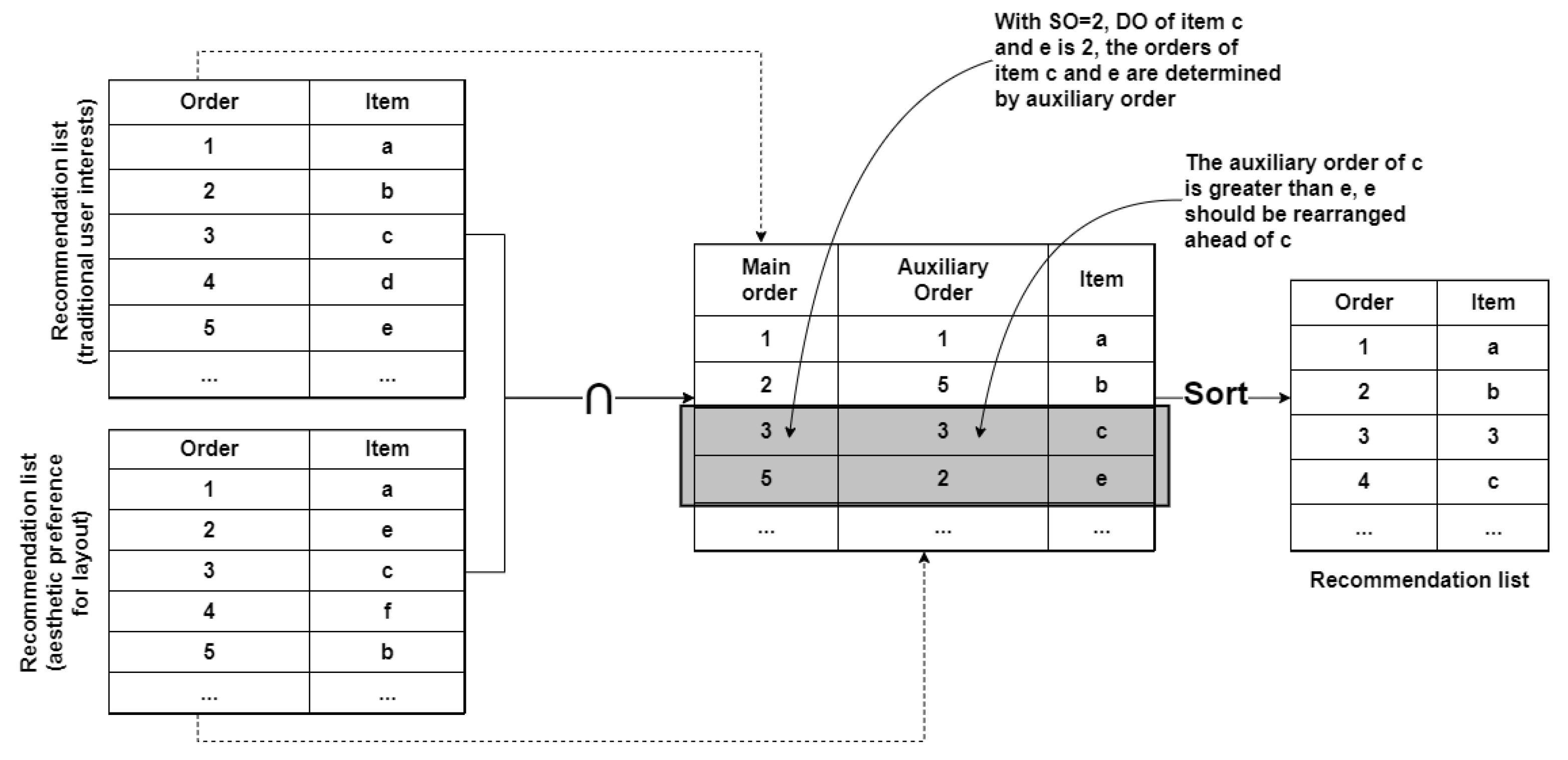
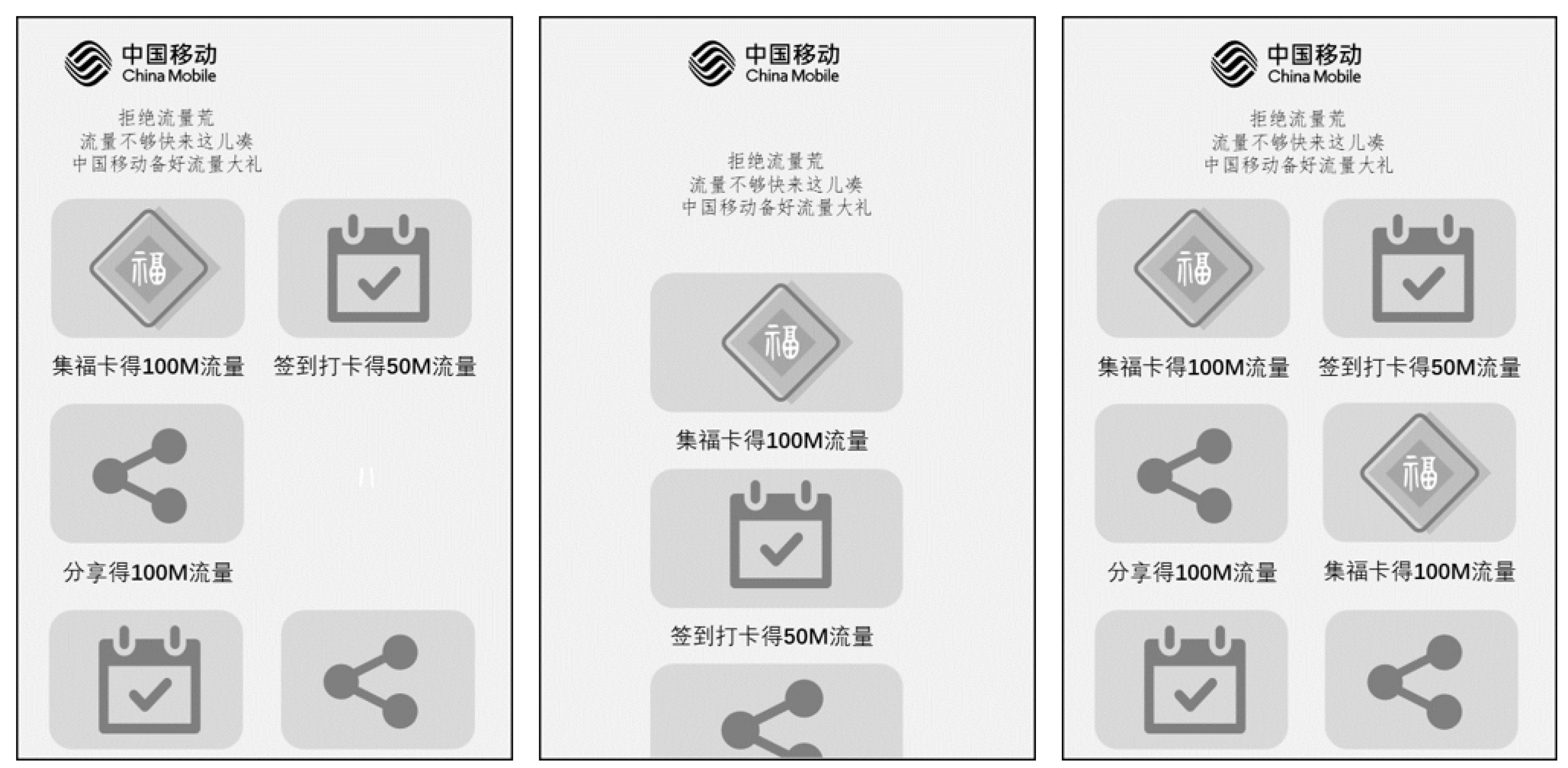

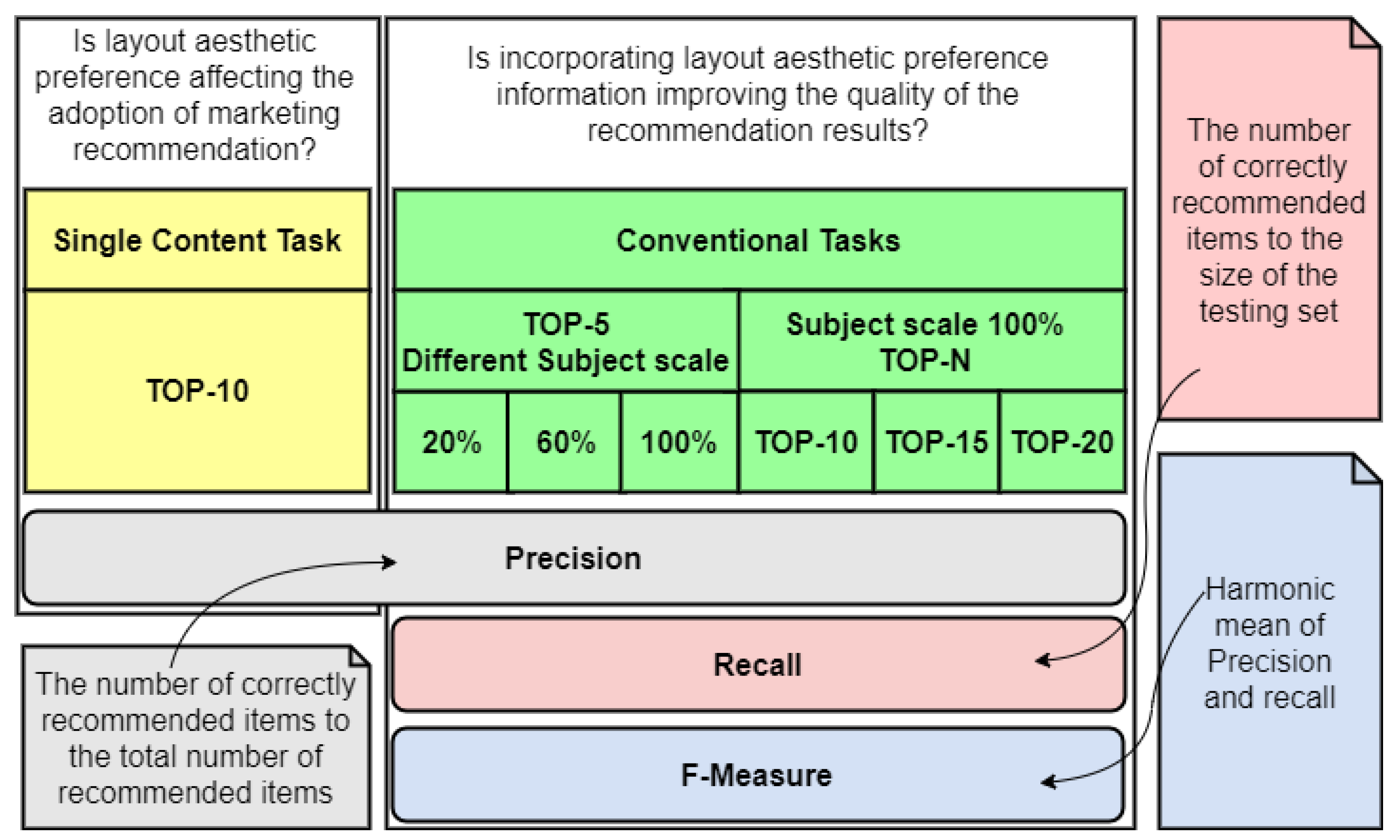

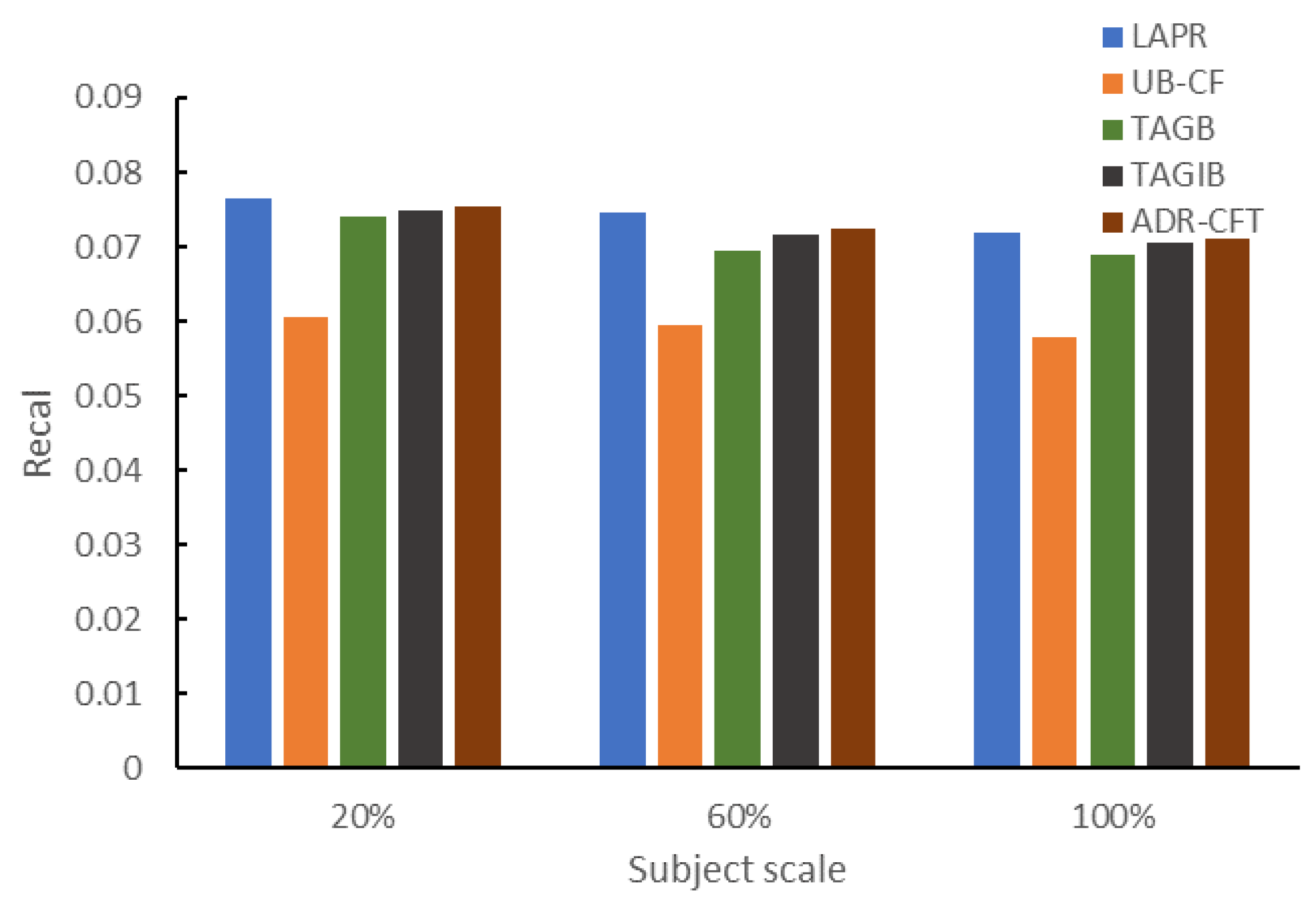
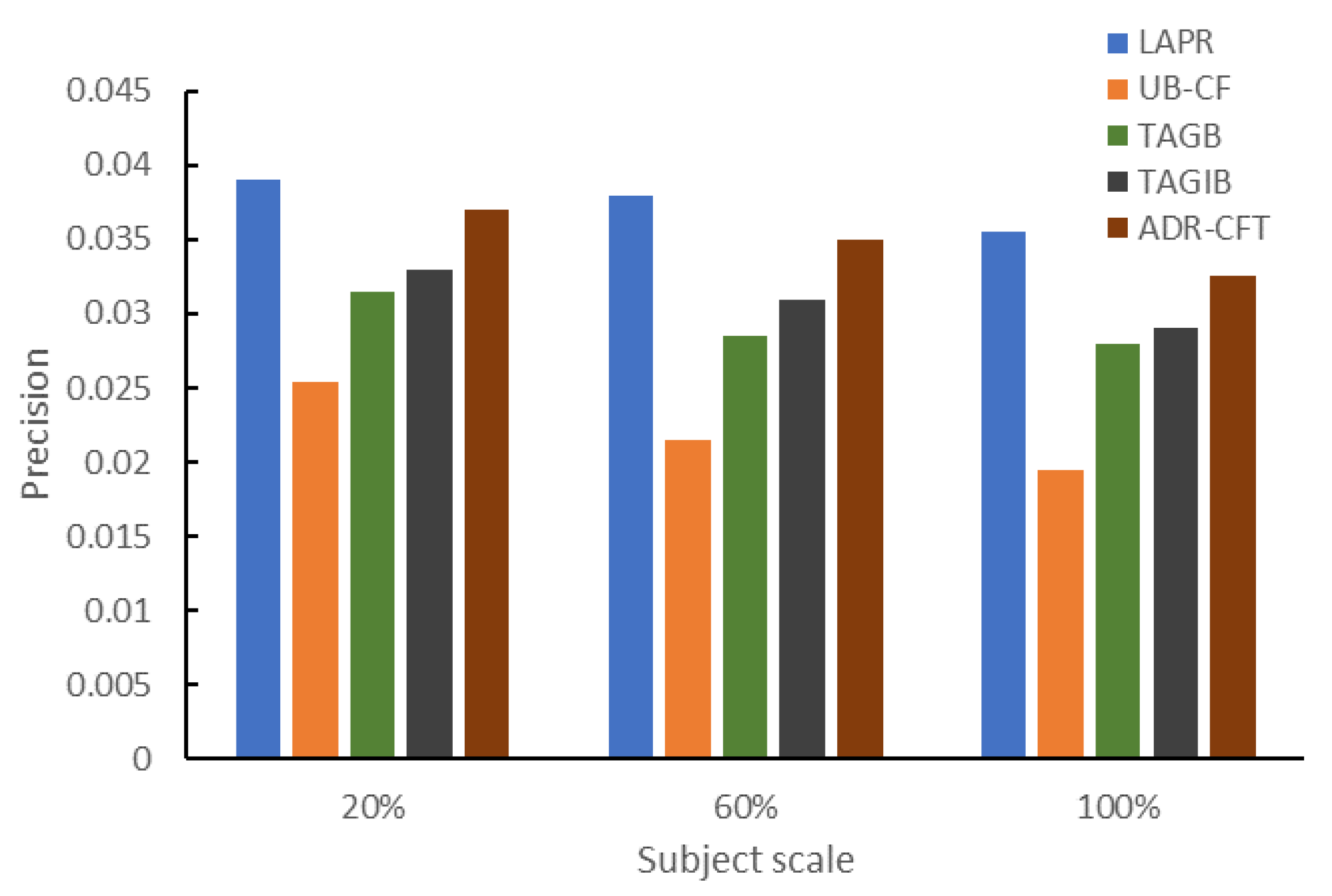


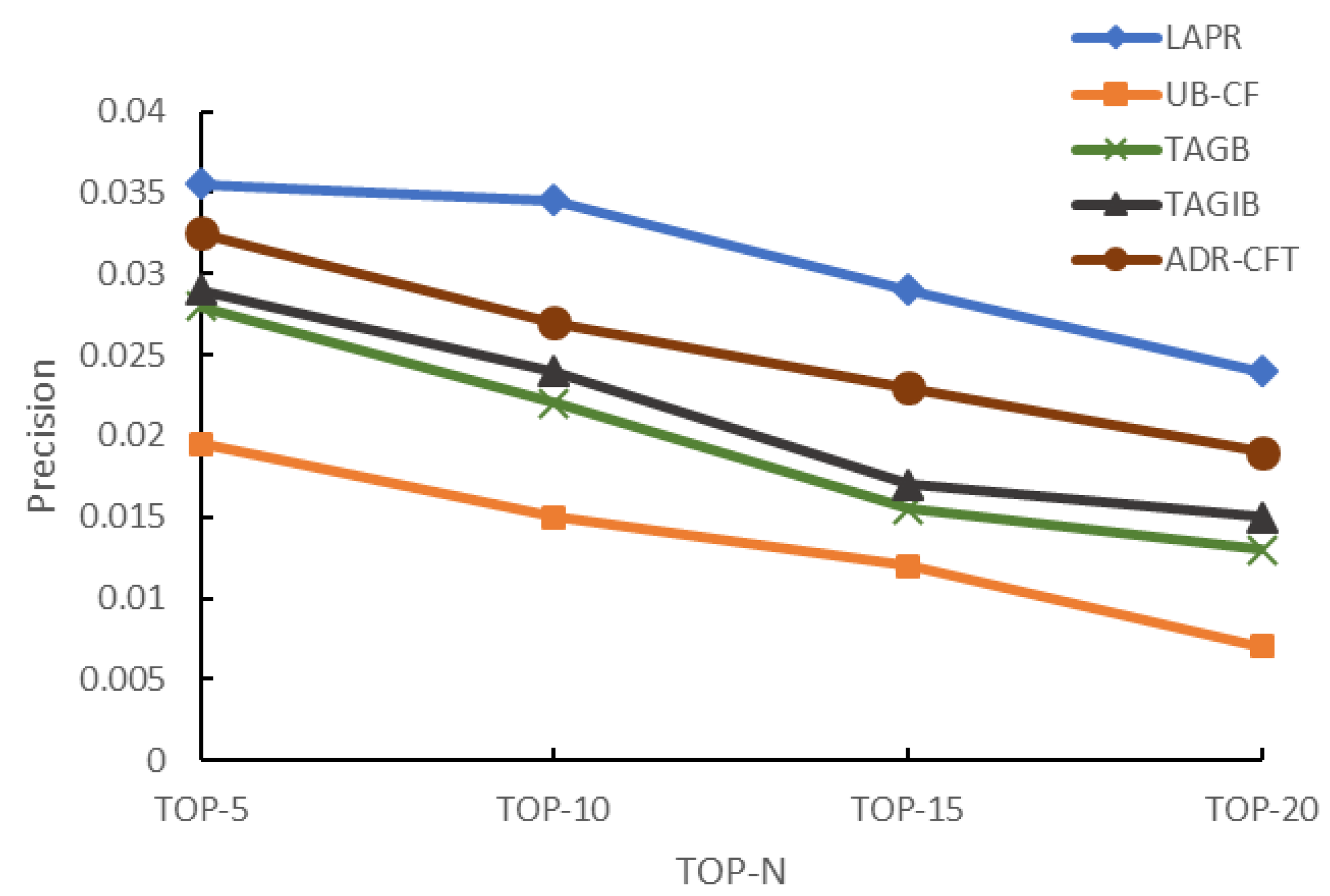

| Method | LAPR | UB-CF | TAGB | TAGIB | ADR-CFT |
|---|---|---|---|---|---|
| Precision | 0.3893 | 0.1814 | 0.1765 | 0.1861 | 0.1881 |
| Subject Scale | LAPR | UB-CF | TAGB | TAGIB | ADR-CFT |
|---|---|---|---|---|---|
| 20% | 0.0765 | 0.0605 | 0.0745 | 0.0752 | 0.0755 |
| 60% | 0.0745 | 0.0595 | 0.0695 | 0.0715 | 0.0725 |
| 100% | 0.0723 | 0.0581 | 0.0696 | 0.0705 | 0.0712 |
| Subject Scale | LAPR | UB-CF | TAGB | TAGIB | ADR-CFT |
|---|---|---|---|---|---|
| 20% | 0.0393 | 0.0254 | 0.0315 | 0.0331 | 0.0372 |
| 60% | 0.0381 | 0.0215 | 0.0285 | 0.0313 | 0.0353 |
| 100% | 0.0355 | 0.0195 | 0.0284 | 0.0291 | 0.0325 |
| Subject Scale | LAPR | UB-CF | TAGB | TAGIB | ADR-CFT |
|---|---|---|---|---|---|
| 20% | 0.0517 | 0.0358 | 0.0442 | 0.0458 | 0.0497 |
| 60% | 0.0503 | 0.0316 | 0.0404 | 0.0432 | 0.0472 |
| 100% | 0.0476 | 0.0292 | 0.0398 | 0.0411 | 0.0446 |
| TOP-N | LAPR | UB-CF | TAGB | TAGIB | ADR-CFT |
|---|---|---|---|---|---|
| TOP-5 | 0.0726 | 0.0583 | 0.0695 | 0.0705 | 0.0713 |
| TOP-10 | 0.0695 | 0.0455 | 0.0605 | 0.0605 | 0.0615 |
| TOP-15 | 0.0605 | 0.0369 | 0.052 | 0.0525 | 0.0538 |
| TOP-20 | 0.0475 | 0.0255 | 0.0427 | 0.0405 | 0.0415 |
| TOP-N | LAPR | UB-CF | TAGB | TAGIB | ADR-CFT |
|---|---|---|---|---|---|
| TOP-5 | 0.0355 | 0.0195 | 0.0282 | 0.0293 | 0.0325 |
| TOP-10 | 0.0345 | 0.0153 | 0.0224 | 0.0245 | 0.0271 |
| TOP-15 | 0.0294 | 0.0126 | 0.0155 | 0.0174 | 0.0235 |
| TOP-20 | 0.0247 | 0.0073 | 0.0131 | 0.0152 | 0.0197 |
| TOP-N | LAPR | UB-CF | TAGB | TAGIB | ADR-CFT |
|---|---|---|---|---|---|
| TOP-5 | 0.0476 | 0.0292 | 0.0398 | 0.0411 | 0.0446 |
| TOP-10 | 0.0461 | 0.0226 | 0.0323 | 0.0344 | 0.0375 |
| TOP-15 | 0.0392 | 0.0180 | 0.0239 | 0.0257 | 0.0321 |
| TOP-20 | 0.0319 | 0.0110 | 0.0196 | 0.0219 | 0.0261 |
© 2020 by the authors. Licensee MDPI, Basel, Switzerland. This article is an open access article distributed under the terms and conditions of the Creative Commons Attribution (CC BY) license (http://creativecommons.org/licenses/by/4.0/).
Share and Cite
Xiao, L.; Mao, H.; Wang, S. Research on Mobile Marketing Recommendation Method Incorporating Layout Aesthetic Preference for Sustainable m-Commerce. Sustainability 2020, 12, 2496. https://doi.org/10.3390/su12062496
Xiao L, Mao H, Wang S. Research on Mobile Marketing Recommendation Method Incorporating Layout Aesthetic Preference for Sustainable m-Commerce. Sustainability. 2020; 12(6):2496. https://doi.org/10.3390/su12062496
Chicago/Turabian StyleXiao, Liang, Hangxiao Mao, and Shu Wang. 2020. "Research on Mobile Marketing Recommendation Method Incorporating Layout Aesthetic Preference for Sustainable m-Commerce" Sustainability 12, no. 6: 2496. https://doi.org/10.3390/su12062496
APA StyleXiao, L., Mao, H., & Wang, S. (2020). Research on Mobile Marketing Recommendation Method Incorporating Layout Aesthetic Preference for Sustainable m-Commerce. Sustainability, 12(6), 2496. https://doi.org/10.3390/su12062496




